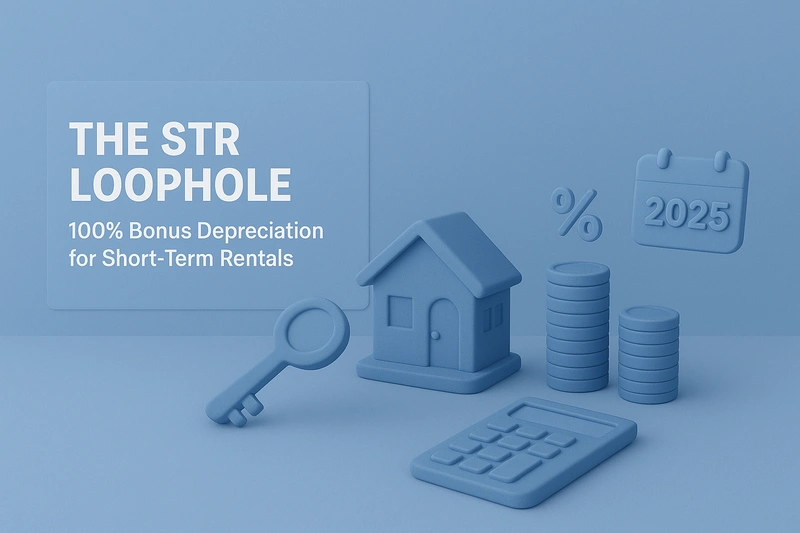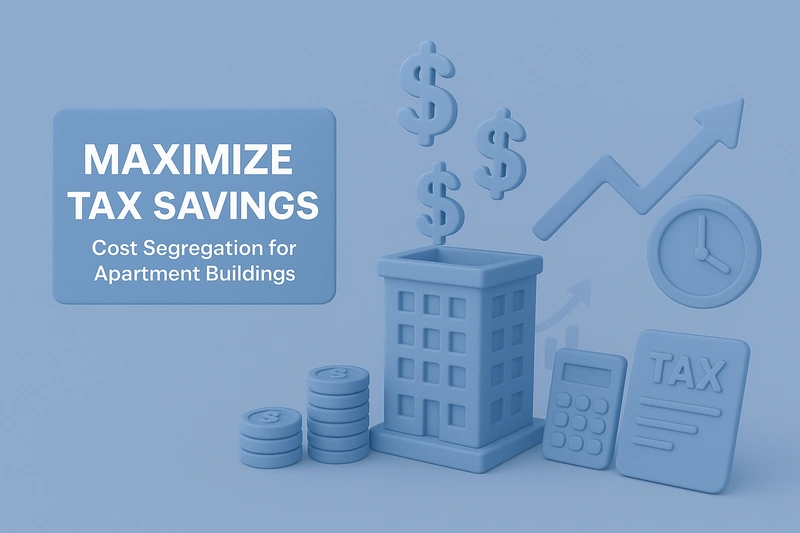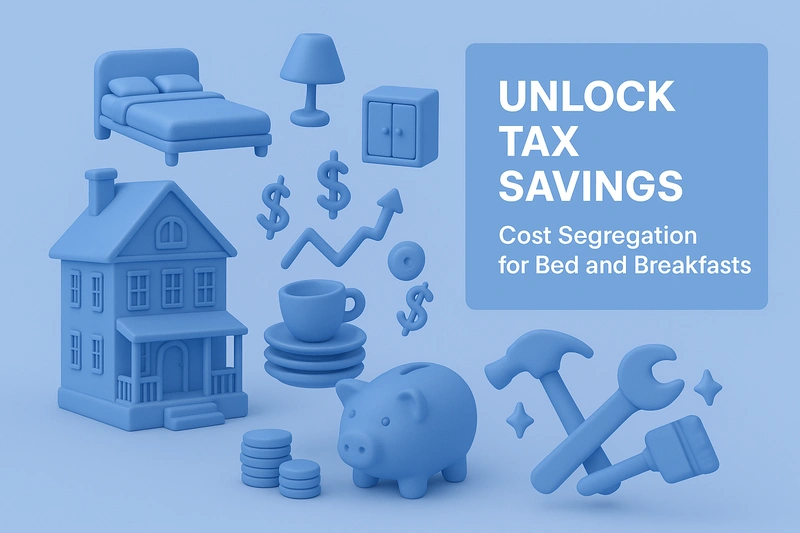The Big Beautiful Bill has restored 100% bonus depreciation, creating an immediate opportunity for short-term rental investors. This legislative change means qualifying STR properties can generate first-year deductions exceeding $150,000 on a $500,000 investment.
Short-term rental properties operate under different tax rules than traditional rentals. When the average guest stay falls below seven days, these properties qualify as active businesses rather than passive investments. This distinction unlocks accelerated depreciation benefits typically unavailable to standard rental property owners.
The combination of restored 100% bonus depreciation and cost segregation services creates substantial year-one tax savings. A properly executed cost segregation study on an STR property identifies 25-30% of the purchase price eligible for immediate write-off. For high-income investors, this translates to tax savings of $50,000 or more in the acquisition year.
R.E. Cost Seg has analyzed hundreds of STR properties since the bonus depreciation revival. The data shows consistent patterns: investors who understand this tax strategy reduce their effective tax rate by 15-20% in year one.
What Makes Short-Term Rentals Different?
Short-term rentals with average stays of seven days or less receive active business treatment under IRS guidelines. This classification fundamentally changes the depreciation landscape compared to traditional rental properties.
Traditional long-term rentals face passive activity loss limitations unless the owner achieves real estate professional status. STR properties bypass this requirement through material participation rules. An owner who participates 100+ hours annually in their STR operations can deduct losses against ordinary income without a real estate professional designation.
The tax code treats STR properties as Schedule C businesses when properly structured. This treatment enables accelerated depreciation deductions that offset W-2 income, business profits, and investment gains.
Breaking Down the Numbers
Consider a $500,000 STR property purchase with $400,000 allocated to improvements:
Traditional Rental Depreciation:
- Annual deduction: $14,545 (27.5-year straight-line)
- First-year tax savings at 35% rate: $5,091
STR with Cost Segregation and 100% Bonus Depreciation:
- Accelerated components identified: $120,000
- First-year deduction: $134,545
- First-year tax savings at 35% rate: $47,091
The $42,000 difference in year-one tax savings represents immediate capital available for reinvestment.
Documentation Requirements: Material participation demands detailed record-keeping. Guest communications, property management decisions, and improvement planning all count toward hourly requirements. R.E. Cost Seg recommends contemporaneous logs documenting all STR-related activities to support deduction claims during potential IRS examinations.
Form 3115 may be required when changing depreciation methods on existing STR properties.
How Short-Term Rental Cost Segregation Works
Cost segregation studies reclassify building components from 27.5-year property into shorter recovery periods. Engineering-based analyses identify personal property and land improvements eligible for accelerated depreciation. These studies require detailed property evaluation, often including site visits to document qualifying assets.
R.E. Cost Seg typically identifies 25-30% of an STR's basis as five, seven, or fifteen-year property. The IRS accepts properly documented engineering studies that follow established audit technique guidelines. Professional studies withstand scrutiny better than rule-of-thumb estimates.
Property components move from Section 1250 (real property) to Section 1245 (personal property) classification. This reclassification enables 100% bonus depreciation on qualified assets placed in service through 2025.
Maximizing Your Airbnb Depreciation
Airbnb properties contain significant personal property eligible for acceleration:
5-Year Property:
- Furniture, mattresses, and bedding
- Kitchen appliances and cookware
- Electronics and entertainment systems
- Decorative fixtures and artwork
- Window treatments
7-Year Property:
- Outdoor furniture
- Recreational equipment
15-Year Property:
- Driveways and walkways
- Landscaping and irrigation
- Fencing and outdoor lighting
- Parking areas
Land value remains non-depreciable regardless of classification.
Real-World Example
$600,000 beach house conversion to STR:
- Purchase price: $600,000
- Land value: $150,000
- Depreciable basis: $450,000
Cost Segregation Results:
- 5-year property: $90,000 (20%)
- 7-year property: $27,000 (6%)
- 15-year property: $45,000 (10%)
- 27.5-year property: $288,000 (64%)
First-Year Depreciation:
- With 100% bonus depreciation: $162,000 + $10,473 = $172,473
- Without cost segregation: $16,364
- Additional first-year deduction: $156,109
At a 37% tax rate, this generates $57,760 in immediate tax savings. The cost segregation study pays for itself multiple times over in year one alone.
Recapture considerations apply when selling. Section 1245 property recaptures as ordinary income, while Section 1250 property receives capital gains treatment.
The 100% Bonus Depreciation Revival
The Big Beautiful Bill reversed scheduled bonus depreciation phase-outs. Without this legislation, bonus depreciation would have dropped to 40% in 2025. Instead, qualifying property now receives 100% first-year write-offs.
This restoration affects all MACRS property with recovery periods of 20 years or less. STR investors benefit immediately from this change. Properties acquired and placed in service after January 20th qualify for full acceleration.
The acquisition date determines eligibility. Properties purchased under binding contracts after the bill's enactment qualify. Used property acquired after September 27, 2017, also qualifies when meeting original use requirements for the taxpayer.
Qualifying Property for STRs
Bonus depreciation applies to specific asset categories:
Eligible Components:
- All 5, 7, and 15-year property identified through cost segregation
- Qualified improvement property (post-2017 interior improvements)
- Computer software and equipment
- Appliances and furnishings
Ineligible Components:
- 27.5-year structural components
- Land value
- Intangible assets
R.E. Cost Seg analysis shows that typical STR properties contain $30,000-50,000 per bedroom in qualifying assets. A four-bedroom property often yields $120,000-200,000 in bonus-eligible depreciation.
Material Participation: The Key to the STR Loophole
Material participation transforms STR depreciation from passive losses to active deductions. The IRS provides seven tests. Meeting any single test qualifies the activity as material participation.
Primary Tests for STR Owners:
- 500-Hour Test: Participate more than 500 hours annually
- Substantially All Test: Provide substantially all participation in the activity
- 100-Hour Test: Participate 100+ hours with no other individual participating more
- Significant Participation: Combine multiple rental activities exceeding 500 hours total
Most STR owners satisfy the 100-hour test. Activities counting toward participation include guest communication, pricing decisions, property maintenance coordination, listing management, and improvement planning.
The IRS distinguishes between investor activities and operational participation. Reviewing financial statements doesn't count. Managing guest issues does. R.E. Cost Seg recommends detailed time logs documenting specific tasks and durations.
Documentation Strategies for STR Owners
Contemporaneous records prove material participation during audits. Digital calendars, property management software reports, and communication logs provide supporting evidence.
Qualifying Activities:
- Guest check-in coordination and problem resolution
- Cleaning and maintenance scheduling
- Dynamic pricing adjustments
- Marketing and listing optimization
- Supply purchasing and inventory management
- Contractor supervision for improvements
Non-Qualifying Activities:
- Long-term investment planning
- Reviewing financial reports
- Travel to investment seminars
Property management companies complicate material participation. Owners must retain substantial decision-making authority. Strategic oversight combined with direct guest interaction often satisfies requirements.
Site visits for property improvements and regular inspections contribute to hourly totals. Document purpose, duration, and specific activities performed during each visit.
Without material participation, STR losses remain passive despite the seven-day rule. This limitation prevents offset against ordinary income, eliminating the primary tax advantage. Investors must commit operational time to unlock depreciation benefits.
Real estate professional status provides an alternative path but requires 750 hours annually across all real estate activities.
Implementation Strategies and Timing
Timing determines the total tax benefit from STR cost segregation. Fourth-quarter acquisitions still qualify for full-year depreciation under half-year convention rules. This creates planning opportunities for high-income years, with W-2 earners who earn $ 250,000 or more benefiting most from immediate implementation.
Multiple property strategies require sequencing. Acquire the highest-value properties first to maximize bonus depreciation. Stagger purchases across tax years when income varies significantly.
Cost segregation studies take 2-4 weeks from engagement. R.E. Cost Seg recommends initiating studies immediately after closing to ensure current-year deduction capture.
Common Investor Scenarios
High-Income Professional: $400,000 W-2 income acquires $750,000 STR. Cost segregation identifies $225,000 in accelerated depreciation. Tax savings: $83,250 in year one.
Portfolio Builder: Three STR properties totaling $1.5 million. Staggered acquisition captures $450,000 in bonus depreciation across two tax years. Strategic timing matches deductions with peak income years.
1031 Exchange into STR: Deferred gain carries forward. The new property basis qualifies for cost segregation. Bonus depreciation applies to improvements, not land value. Form 3115 may be required for depreciation method changes.
Consider state tax implications. Some states don't conform to federal bonus depreciation rules. California, for example, requires separate depreciation schedules.
Risks and Considerations
The Recapture Reality
Section 1245 property accelerated through cost segregation faces ordinary income recapture upon sale. A $100,000 bonus depreciation deduction taken at 37% saves $37,000 initially but creates equivalent ordinary income if sold immediately at a gain.
Strategic holding periods minimize recapture impact. Properties held 5+ years benefit from the time value of money despite eventual recapture. 1031 exchanges defer but don't eliminate recapture obligations.
Section 1250 property (27.5-year components) maintains capital gains treatment. Only depreciation exceeding straight-line triggers recapture. This distinction makes proper classification critical during cost segregation studies.
IRS Scrutiny Points
STR classification requires consistent seven-day average rental periods. Mixed-use properties with occasional longer stays risk reclassification. Maintain detailed booking records proving compliance.
Material participation documentation faces examination. IRS agents request contemporaneous logs, not reconstructed records. Calendar entries must show specific activities, not generic "property management" descriptions.
Cost segregation quality varies significantly. R.E. Cost Seg follows the IRS Audit Technique Guide standards. Engineering-based studies with site visits provide stronger audit defense than desktop estimates.
Local STR regulations present ongoing risks. Cities implementing rental restrictions may eliminate STR classification. Depreciation already taken remains valid, but future benefits disappear. Monitor regulatory changes in target markets.
Professional guidance prevents costly errors. Incorrect Form 3115 filing or improper basis allocation triggers amendments and penalties.
Action Steps for Investors
Your STR Tax Strategy Checklist
Execute these steps to capture maximum depreciation benefits:
- Verify STR qualification: Document average rental periods under seven days through booking platform reports
- Establish material participation: Create a time-tracking system before year-end
- Engage cost segregation services: R.E. Cost Seg requires 2-4 weeks for a comprehensive analysis, including site visits
- Calculate basis correctly: Separate land value from improvements using property tax assessments or appraisals
- File Form 3115 if needed: Required when changing depreciation methods on existing properties
- Coordinate with tax preparer: Provide cost segregation report and participation logs before filing
Cost-Benefit Analysis Framework
Cost segregation makes economic sense when:
- Property value exceeds $250,000
- Improvement basis represents 70%+ of the purchase price
- Current year income exceeds $150,000
- Material participation requirements are met
ROI Calculation:
- Cost segregation study fee: $950-$5,000
- First-year tax savings: $30,000-100,000+
- Typical payback period: 2-4 months
Break-even Analysis: Properties generating $15,000+ in bonus depreciation justify professional studies. Below this threshold, recapture risk may outweigh benefits.
R.E. Cost Seg provides preliminary benefit analyses before engagement. This assessment determines whether full studies warrant investment. Properties with minimal personal property or high land value may not qualify for significant acceleration.
Key Takeaways
Thanks to the Big Beautiful Bill's 100% bonus depreciation, STR properties qualifying through seven-day average rentals and material participation can generate immediate five to six-figure tax deductions. Cost segregation studies identify 25-30% of property basis for acceleration.
Critical requirements remain non-negotiable: maintain detailed participation records, ensure consistent STR qualification, and engage qualified professionals for engineering-based studies.






